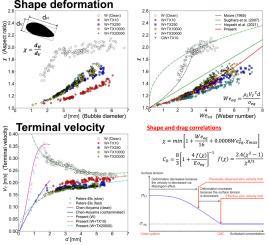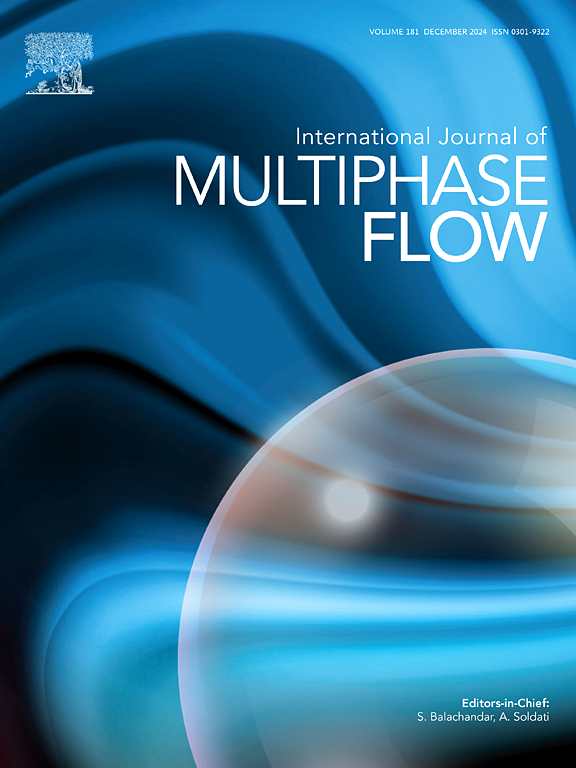表面活性剂浓度超过CMC的滞水中出现单个变形气泡
IF 3.8
2区 工程技术
Q1 MECHANICS
International Journal of Multiphase Flow
Pub Date : 2025-09-10
DOI:10.1016/j.ijmultiphaseflow.2025.105440
引用次数: 0
摘要
对Triton X-100水溶液中超过临界胶束浓度(CMC)的变形气泡进行了实验,以了解气泡在所谓的完全污染状态下的行为。当浓度C为10 mmol/m3 (<;CMC=240 mmol/m3)时,终端速度显著降低,速度数据符合众所周知的污染体系慢速度曲线。然而,从C超过CMC时可以看出,末端速度进一步下降,而在C=10,000和20,000 mmol/m3浓度下的速度相同,表明在这些浓度下气泡完全被污染了。在Re-Eo平面上,通过有效表面张力σeq计算吸附和解吸平衡的Eötvös数,污染气泡的雷诺数与具有σeq有效莫顿数的高黏度体系中的气泡雷诺数一致。因此,气泡被表面活性剂完全覆盖,从而导致表面张力降低和马兰戈尼效应。表面活性剂的存在降低了气泡的形状变形,并且当C=10,000和20,000 mmol/m3时,气泡的长径比相同,再次表明在这些浓度下气泡被完全污染。为σeq定义的韦伯数很好地关联了污染气泡的形状。建立了污染气泡的形状相关性,并通过引入气泡变形的影响扩展了可用的阻力相关性,以再现清洁气泡和污染气泡的快慢速度曲线,这些气泡在形状和路径振荡方面表现出不同的特征,特别是在C超过CMC时。本文章由计算机程序翻译,如有差异,请以英文原文为准。

Single deformed bubbles rising through stagnant water of surfactant concentrations beyond CMC
Experiments were conducted on deformed bubbles in Triton X-100 aqueous solutions at concentrations exceeding the critical micelle concentration (CMC) to understand the bubble behavior in the so-called fully-contaminated state. The terminal velocity was significantly reduced at a concentration of 10 mmol/m3 ( mmol/m3), and the velocity data were in agreement with the well-known slow velocity curve for contaminated systems. However, as indicated in beyond CMC, the terminal velocity experienced a further decrease, while the velocities at concentrations of and 20,000 mmol/m3 were the same, suggesting that at these concentrations the bubbles were completely contaminated. In the - plane, where the Eötvös number was calculated by the effective surface tension, , for the equilibrium of adsorption and desorption, the bubble Reynolds numbers of contaminated bubbles agreed with those in a higher viscosity system with the effective Morton number for . Therefore, bubbles were considered to be fully covered by surfactant, which causes the surface tension reduction and the Marangoni effect. The presence of surfactant decreased the shape deformation, and the aspect ratios for and 20,000 mmol/m3 were the same, again showing that the bubbles at these concentrations were fully contaminated. The Weber number defined for worked well to correlate the shapes of contaminated bubbles. A shape correlation for contaminated bubbles was developed, and an available drag correlation was extended by introducing the effects of bubble deformation to reproduce the fast and slow velocity curves of clean and contaminated bubbles that exhibit different characteristics in shape and path oscillations, in particular at beyond CMC.
求助全文
通过发布文献求助,成功后即可免费获取论文全文。
去求助
来源期刊
CiteScore
7.30
自引率
10.50%
发文量
244
审稿时长
4 months
期刊介绍:
The International Journal of Multiphase Flow publishes analytical, numerical and experimental articles of lasting interest. The scope of the journal includes all aspects of mass, momentum and energy exchange phenomena among different phases such as occur in disperse flows, gas–liquid and liquid–liquid flows, flows in porous media, boiling, granular flows and others.
The journal publishes full papers, brief communications and conference announcements.

 求助内容:
求助内容: 应助结果提醒方式:
应助结果提醒方式:


